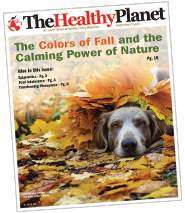St. Louis Area Fine Arts, Crafts & Performing Arts
By Michelle “Mike” Ochonicky, Arts Editor
A Consideration of Color…
Just the other day, as I was walking into a major retailer, I passed a woman exiting the store. She had blue lips. Not pale blue lips but bright, electric, royal blue lips. Otherwise, she was quite average and unremarkable in her makeup and dress—nothing unusual to notice, except for her very blue lips. They were quite noticeable. And that made me start to think about color and to question what we consider to be “natural color.” Lipstick comes in lots of shades: red lips and pink lips and even orange lips seem quite “normal,” don’t they?
But they’re not.
Lips are not naturally red. Lips are not naturally pink or hot pink. And no one’s lips are naturally orange. But those colors wouldn’t necessarily call attention, would they? Not the way blue lips do. So why is that? What makes us read some colors as “natural” but other colors as odd?
When I was in high school, I worked at a local card and gift shop. The main full-timer who worked there was an older lady (probably much younger than I am now, but “older” is a relative term when you’re 17). She was very nice, but the main thing I remember about her was the fact that she always wore fuschia lipstick. Yep, fuschia. Always. No matter what color clothing she wore. And yes, it was unusual back then. Funny how I still remember that.
And let’s not even begin to discuss the wild array of colors for nails or hair. Frankly, I like to see interesting hair colors. Why not blue, or pink, or copper? Really, if people color their hair, who says it has to be brown, black or blonde? Unusual colors seem more fun.
Which brings me to the point of this article: what is natural color? It’s indefinable, really. If “beauty is in the eye of the beholder,” maybe natural color is as well.
I once saw an impressionist painting of blossoming trees in springtime and overheard another viewer’s comment that the painting wasn’t very realistic. Well, I’ve seen pale pink and bright pink and lavender blossoms on various trees in springtime, so those colors are realistic. Trees are not always green.
Singer/songwriter Harry Chapin did a song in the ‘70’s about a child whose artistic “voice” was limited when a teacher told him that “Flowers are red, and leaves are green. There’s no need to see flowers any other way, Than they way they always have been seen” The song goes on, until the child eventually has a teacher who says, “There are so many colors in the rainbow and I see every one!”
I’ve seen incredible sunsets that fill the sky with orange, red, gold and pink, just as the same colors can be seen sometimes at sunset. Awesome! And proof that the sky is not always blue.
Mother Nature is pretty good with her paintbrush in autumn as well as leaves take on metallic hues. People will travel miles just to view the autumn leaves when the colors start to turn. Some even argue over which weekend offers the best color. They don’t travel to see the green; they travel to see the colors.
Don’t we consider it a treat to view a full orange moon on a clear night? And winter snow does sometimes look more blue than white as it reflects the light.
We humans simply love color! Pablo Picasso noted, “Colors, like features, follow the changes of emotions.” Colors bring out emotions. “Artists and interior designers have long understood how color can dramatically affect moods, feelings, and emotions,” writes psychologist Kendra Cherry in her studies of color’s influence on people. “It (color) is a powerful communication tool and can be used to signal action, influence mood, and cause physiological reactions.”
Given the prevalence of color, one would expect color psychology to be a well-developed area,” note researchers Andrew Elliot and Markus Maier of the University of Rochester. “Surprisingly, little theoretical or empirical work has been conducted to date on the influence of color on psychological functioning, and the work that has been done has been driven mostly by practical concerns, not scientific rigor.” So, umm, the experts don’t know exactly why we like colors either…
It’s an interesting concept to ponder: why do we interpret some colors as being natural, especially when all colors are found in nature? So, why not blue lips???
You can see “ArtFul Happenings” at TheHealthyPlanet.com


